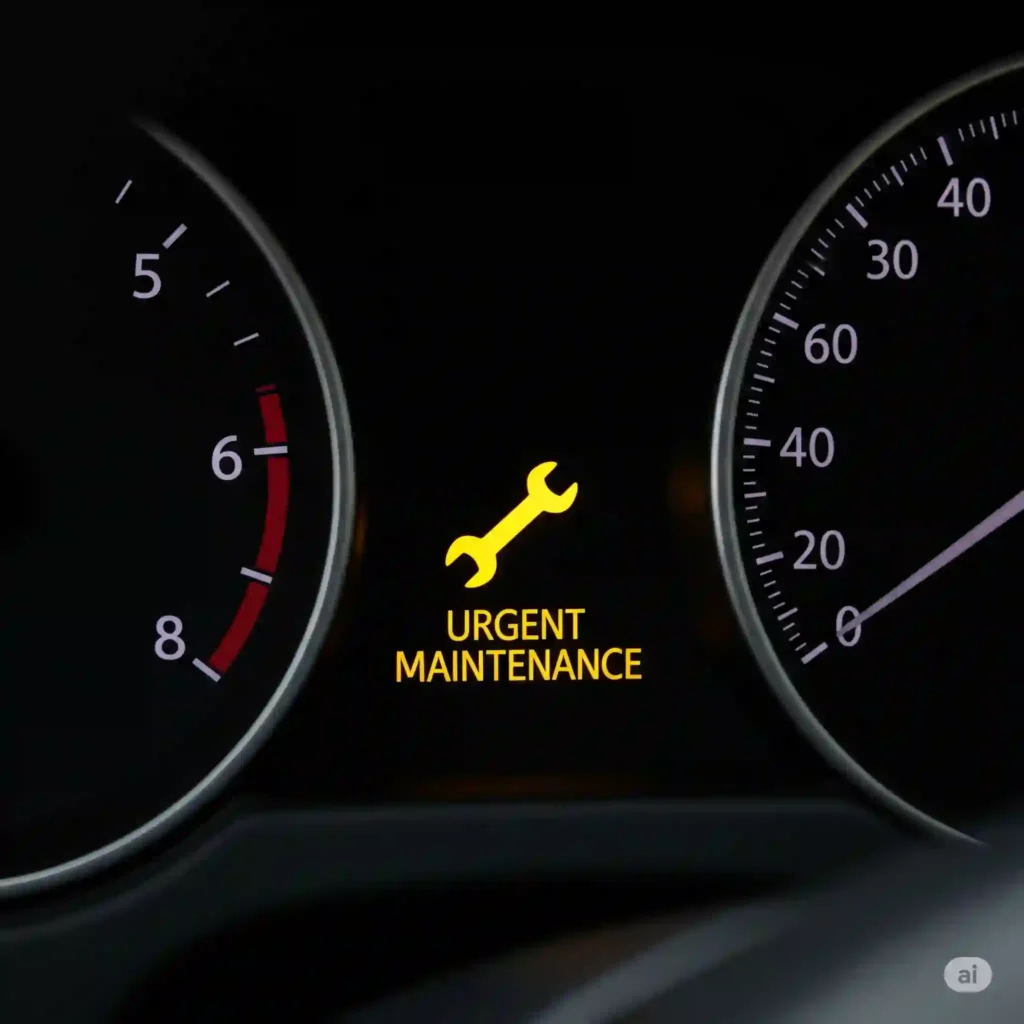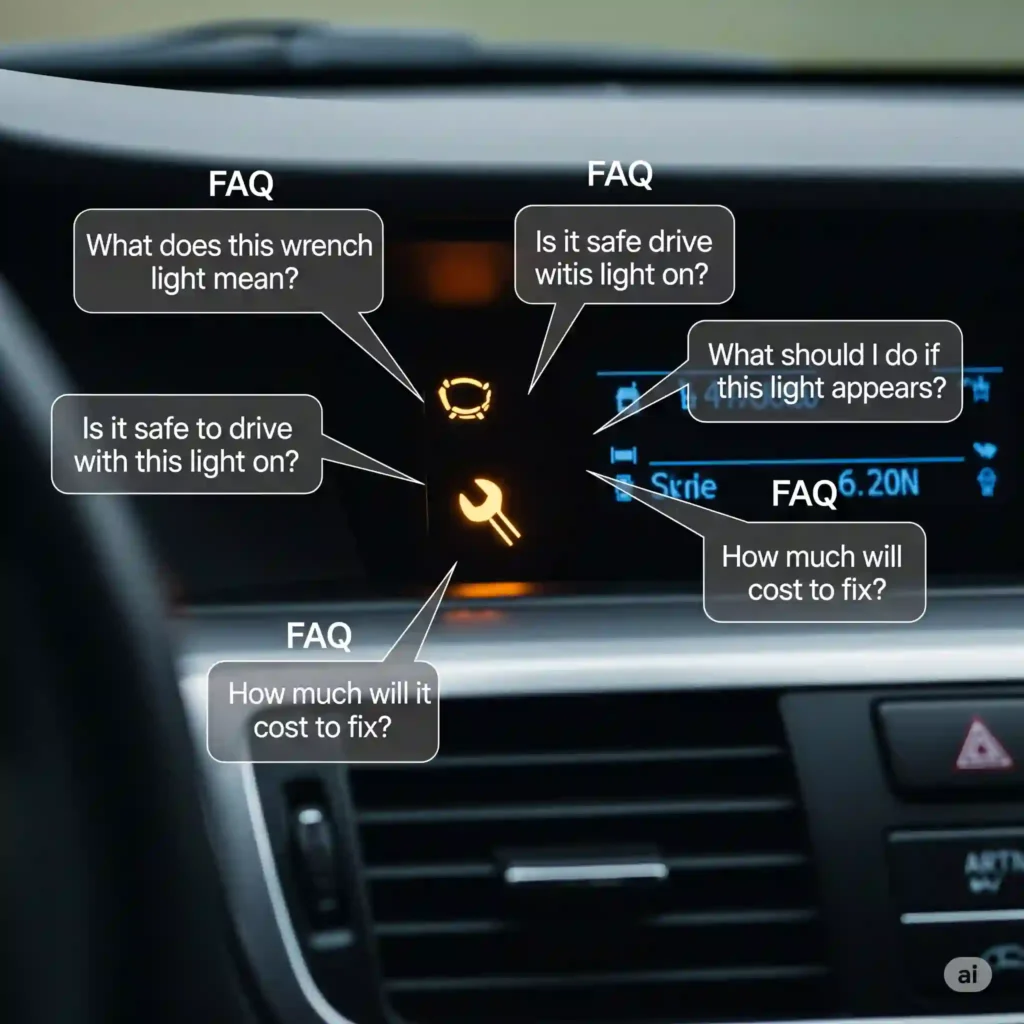It happened on a Monday morning—I’m halfway to work when suddenly, a wrench symbol popped up on my dashboard. My first thought? What does the tool light mean on a car, and am I about to be stranded? If you’ve seen that car light with a wrench and felt your stomach drop, you’re not alone. Over the years, I’ve learned how these lights—especially the wrench light on Ford or the wrench symbol on dashboard Honda—can mean anything from a routine oil change to a more serious issue. In this guide, I’ll break it all down in plain English, share what’s happened in my own experience, and help you figure out what to do next. Let’s get into it—because knowing what that light means might just save you time, stress, and money.
What Does the Tool Light Mean on a Car?
When that wrench symbol shows up on your dashboard, it’s easy to panic—but take a breath. The tool light (or wrench light) usually means your car needs some kind of maintenance. It’s not always bad news. In most cases, it’s just your car’s way of saying, “Hey, it’s time for a checkup.”
On many cars, the wrench light is a reminder for scheduled service, like an oil change or tire rotation. But depending on the make and model, it can also point to something more specific, like a sensor issue or throttle problem. For example, the wrench light on Ford vehicles often signals a powertrain issue, while the wrench symbol on dashboard Honda models is part of their regular maintenance minder system.
I remember the first time I saw that little wrench. My heart dropped—I thought something was broken. But after a quick scan and a chat with my mechanic, it turned out to be a simple service reminder. If the light came on after a long drive or right before a routine service, that’s probably what it is.
So, what does the tool light mean on a car? In short: it’s your car’s way of nudging you to pay attention. It might be a gentle reminder, or it could be flagging an early sign of a bigger issue. Either way, it’s worth checking out sooner than later—your car will thank you for it.
Common Causes of the Wrench Light (Tool Light) Activation
So, you’re driving along, everything feels normal—and then boom, that little car light with a wrench shows up. It’s easy to assume the worst, but the truth is, the wrench light often comes on for some pretty common reasons.
Most of the time, it’s just a reminder that your car is due for scheduled maintenance. Think oil change, tire rotation, or a multi-point inspection. It’s your vehicle’s way of saying, “Let’s keep things running smoothly.” On many models, the system is set to light up based on mileage or time intervals—no drama, just routine care.
But sometimes, it’s triggered by minor mechanical issues like throttle body problems. I had this happen on my older Ford. The wrench light on Ford vehicles can signal a throttle control issue, and in my case, the car felt a bit sluggish. I scanned it with a basic OBD2 reader, and sure enough, it was a throttle sensor glitch. One quick reset later, the light was gone—and the car was back to normal.
Another possible reason? Transmission troubles or powertrain faults, especially in Ford and Mazda models. These issues might not always feel urgent, but if your car starts shifting strangely or struggles to accelerate, it’s a sign to get it checked out. The wrench symbol on the dashboard acts like a quiet tap on the shoulder before things get worse.
Electrical or sensor malfunctions can also trigger the tool light, especially if your vehicle’s computer detects something out of range. A loose wire, faulty mass airflow sensor, or something as simple as a dirty connector could be behind it. That’s why checking for codes—even with a cheap scan tool—can give you peace of mind fast.
In some cases, the light is part of a manufacturer-specific alert system. For example, the wrench symbol on dashboard Honda models usually appears as part of their maintenance minder system, with codes that tell you what’s due. It’s less about problems and more about prevention.
From what I’ve seen, the wrench light doesn’t usually mean immediate danger, but it is your car’s way of saying, “Don’t ignore me.” Whether it’s a gentle nudge or an early warning, listening to that signal can save you from bigger problems down the road.
Also Read: Where Can I Buy a Slim Jim Car Tool?
Wrench Symbol on Dashboard by Make & Model
Not all wrench lights mean the same thing—and that’s where things get tricky. The meaning of the wrench symbol depends heavily on your car’s make and model. Some brands use it as a friendly maintenance nudge, while others treat it as a heads-up for a deeper mechanical issue. Let’s break it down so you know what to expect based on what you drive.
Wrench Light on Ford Vehicles
If you drive a Ford, this light can feel a little ominous. On Ford models, the wrench light often means there’s a problem with the powertrain or throttle control system. That might sound intense, but it doesn’t always spell disaster. For example, when I had a 2012 Ford Fusion, the wrench light came on during a cold snap. The car felt a bit jerky when I hit the gas, so I plugged in my OBD2 scanner. Turned out it was a minor throttle actuator issue—nothing serious, and a reset fixed it.
Ford’s diagnostic system is pretty good at pointing you in the right direction. If your Ford feels off—like sluggish acceleration or hard shifts—it’s best to get it checked. In many Ford models, especially the Escape, Explorer, and Fusion, this light can also be linked to electronic throttle control or powertrain faults.
And here’s something I learned the hard way: If the wrench light shows up and your car switches into “limp mode,” it’s your vehicle protecting itself. That limp mode limits engine power to prevent further damage, and that’s your cue to see a mechanic sooner rather than later.
Wrench Symbol on Dashboard Honda
Honda owners, this one’s a little easier. In most Honda models, the wrench light is just part of their Maintenance Minder system. It’s more about routine service than a sign of trouble. The light usually comes with a service code, like A1 or B1, that tells you exactly what your car needs—oil change, tire rotation, fluid check, and so on.
When I drove a Honda Civic, I’d see the wrench light about every few months. The first time, I panicked. But once I looked it up in the manual, it made perfect sense—it was just time for an oil change. If there’s no change in how the car drives, and you see a service code, you’re likely dealing with a scheduled maintenance alert.
That said, if your Honda starts driving weirdly or the light comes on outside of the normal service window, it could be something else. A sensor issue, battery problem, or misfire could also trigger it. So if the car feels off, get it scanned just to be sure.
To sum it up: the wrench light can mean different things depending on your car. On a Ford, it’s often linked to performance or drivetrain issues. On a Honda, it’s usually a reminder to book that next service. Either way, it’s not a light to ignore—but knowing what your car is trying to tell you makes all the difference.
What to Do When You See the Wrench Light
So you’re driving, music on, coffee in hand—and out of nowhere, that little wrench light pops up. Your stomach drops a bit. Is the car about to break down? Am I safe to drive? I’ve been there. And the first thing to do is this: don’t panic.
The wrench light doesn’t usually mean something’s broken. In most cars, it’s a friendly reminder that your vehicle needs attention—kind of like your phone telling you it’s time for an update. Still, it’s not a light to ignore. Think of it as your car raising its hand and saying, “Hey, something’s up.”
The very first step? Check your owner’s manual. I know—nobody really reads those, but this is the one time it comes in handy. Look up the wrench symbol, and you’ll likely find a quick explanation specific to your car. In my Honda Civic, the light came with a service code. In my Ford, it hinted at throttle trouble. Different cars, different meanings.
If your manual isn’t helpful (or you just can’t find it), plug in an OBD2 scanner. These little gadgets are cheap—I got mine online for less than $30—and they tell you exactly what’s going on under the hood. I used one when my Ford’s wrench light came on, and within five minutes, I knew it was a sensor issue. A quick reset, and I was good to go.
Now, let’s say you don’t have a scanner. Ask yourself: Does the car feel different? Is it harder to accelerate? Is the ride jerky? Are there weird sounds? If anything feels off, play it safe and visit a mechanic. If everything feels fine, you probably just need regular service—an oil change, maybe a fluid top-off.
And yes, you can reset the wrench light yourself—in some cases. After I did my own oil change, I followed a few simple steps in my car’s settings to turn the light off. Just make sure the issue is truly resolved before you do. Resetting the light without fixing the cause is like putting tape over a warning sign.
So here’s the bottom line:
- Look up the light in your manual.
- Scan for codes if you can.
- Check how the car feels.
- Don’t ignore it—but don’t freak out either.
Treat the wrench light like a gentle tap on the shoulder—not a slap in the face. Stay calm, take a few simple steps, and you’ll have it figured out faster than you think.
Is It Safe to Drive With the Wrench Light On?
Yes, sometimes—but only if your car still feels and drives normally.
The first time I saw the wrench light while driving, I didn’t pull over. I didn’t panic. But I did turn the music down and paid close attention to how the car felt. No jerking. No odd sounds. Everything seemed fine, and in that moment, it was.
When the wrench light comes on and your car feels totally normal—smooth acceleration, no new sounds, no warning smells—it’s often tied to routine service reminders. Many Honda and Toyota models, for instance, trigger that light when it’s time for an oil change or tire rotation. That’s not an emergency—it’s a helpful nudge.
But the real test isn’t the light—it’s your car’s behavior.
If your vehicle starts acting strange—like sluggish acceleration, jerky shifting, or delayed throttle response—the wrench light could be pointing to a deeper issue. When this happened in my Ford, the car entered “limp mode.” Suddenly, I couldn’t go above 30 mph. That light wasn’t just a suggestion—it was my car protecting itself.
Even without limp mode, any change in performance is a red flag. A smooth ride with a wrench light? Probably okay to drive home or to the shop. A rough ride? That’s your cue to pull over and figure it out. Driving too long with a powertrain or throttle problem can turn a small fix into a costly repair.
Another thing to watch for: if the wrench light shows up with other dashboard lights—like the check engine light—that’s a stronger signal something’s wrong. At that point, it’s not about guessing. Get a scan tool or visit a mechanic to know what you’re dealing with.
So, is it safe to drive with the wrench light on? If it’s the only light on, and the car feels fine, chances are you’ve got some breathing room. But it’s not a pass to ignore it forever. Your car is talking—you just have to listen.
In my experience, the safest approach is simple: trust how your car feels. If it drives fine, schedule a check soon. If something’s off, stop and find out why. Better to catch a $50 fix now than deal with a $1,500 repair later.
Preventing the Wrench Light From Appearing Again
Nobody wants to see that wrench light pop up again—especially not when you’re already running late or halfway through a road trip. The good news? With a little care, you can stop it from showing up in the first place.
The best way to prevent the wrench light from returning is simple: stay on top of your maintenance. I know, it sounds boring—but skipping an oil change or ignoring that “funny noise” can lead straight to dashboard drama. Personally, I started using a calendar reminder for oil changes after forgetting one for months. My car didn’t break down, but the wrench light sure let me know I messed up.
Another thing that helps? Using better fuel and fluids. I used to go for the cheapest gas at the sketchiest stations. Not anymore. After a mechanic told me poor-quality fuel might’ve clogged up my throttle body (which triggered the wrench light), I switched. Since then, no lights, no sputters, no problems. Clean fuel helps your engine stay happy—and quiet.
Listen to your car. That’s one of the biggest lessons I’ve learned. Little things—like rough idling, delayed starts, or weird smells—are your car’s way of saying, “Help me before I make it official with a dashboard warning.” Catching those signs early is how I avoided a costly throttle body replacement last winter.
Also, don’t ignore small checkups. Even if you’re not a “car person,” just doing the basics—checking fluids, inspecting hoses, replacing the air filter—makes a big difference. I spend 10 minutes every few weeks just doing a walk-around. That alone once helped me spot a cracked belt before it became a bigger issue.
So if you’re wondering how to keep the wrench symbol off your dash for good, here’s the quick answer: take care of the small stuff before it turns into big stuff. Regular service, better fuel, listening to your car, and catching tiny changes early—that’s the real magic.
And trust me, it’s a whole lot easier (and cheaper) to spend $40 on maintenance now than $1,000 on a repair later.
 FAQs
FAQs
What does the wrench light mean on a Ford Fusion?
On a Ford Fusion, the wrench light often means there’s a problem with the powertrain or throttle. It can also show up if the car goes into “limp mode.” It’s best to scan for trouble codes or visit a mechanic.
Why did the wrench light come on but go off later?
The wrench light might turn off if the issue was small or the system reset. This can happen after a battery disconnect or short-term issue. But it’s still smart to scan for any saved codes.
Is the wrench light the same as the check engine light?
No, they are not the same. The check engine light warns about engine problems. The wrench light often points to maintenance or powertrain issues. Both should be checked.
Can I reset the wrench light myself?
Yes, in many cars you can reset the light after fixing the problem. Check your owner’s manual for steps. If it’s a service reminder, the reset is often simple.
How long can I drive with the wrench symbol on?
If the car drives normally, you can often drive for a short time. But don’t wait too long. If the car feels odd, stop and get it checked. Catching issues early can save money.
Conclusion
So, what does the wrench light mean on a car? In short: it’s your vehicle’s way of tapping you on the shoulder and saying, “Hey, something needs attention.” Sometimes it’s a simple oil change. Other times, it’s a deeper issue with your throttle or powertrain. Either way, it’s not something to ignore—but it’s also not always a reason to panic.
Personally, I’ve seen this light a few times—once it was just a maintenance reminder, and another time it warned me before a throttle problem got worse. That light saved me from a costly repair because I acted early. That’s the key takeaway here: if the car feels fine, you likely have time. But don’t wait too long to check it out.
The wrench symbol isn’t a red alert—it’s more like a yellow flag. It’s your car saying, “Let’s take care of this before it turns into something bigger.” Whether it’s your Honda asking for an oil change or your Ford signaling a sensor issue, staying proactive makes a huge difference.
So here’s my advice: trust your gut, listen to your car, and take action even if things seem “mostly okay.” Keeping up with small stuff—like using decent fuel or doing quick walk-arounds—can keep that light off for good. I’ve built these habits into my routine, and my car’s been happier for it.
Have you seen the wrench light pop up? What did it mean for you? Share your story in the comments or drop your questions—I’d love to hear how you handled it. Let’s help each other stay ahead of the dashboard drama.

